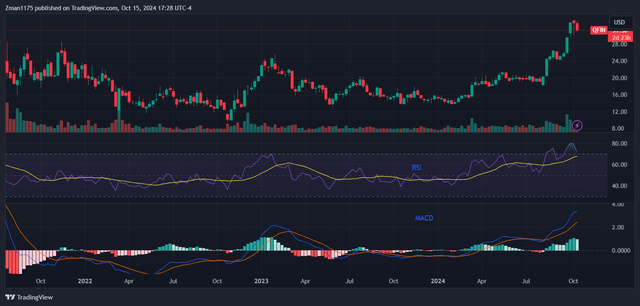Summary:
- Qifu Technology can benefit from increased demand for its credit-based offerings as interest rates become more attractive for borrowers.
- The company’s expected growth could be upgraded due to economic stimulus and Qifu’s effective strategies, thus driving the stock higher.
- Qifu Technology is trading at a bargain valuation, providing significant potential for price-to-earnings (PE) expansion as it continues to grow.
Edwin Tan/E+ via Getty Images
Qifu Technology (NASDAQ:QFIN) can benefit from China’s recent stimulus efforts. Increased demand for Qifu’s credit-based offerings could occur as rates become more attractive for borrowers. QFIN’s expected growth estimates could be upgraded due to the stimulus and the company’s strategies. The stock is trading at a bargain valuation, which leaves a lot of room for PE expansion as Qifu continues its growth.
Qifu Technology’s Company Background
Qifu Technology is a Cayman Islands holding company that conducts operations in China through its subsidiaries and VIEs (variable interest entities). QFIN offers credit-tech services which effectively matches credit demand with credit supply. This is accomplished by offering a suite of technology services to help consumers, small & medium-sized businesses, and financial institutions in the lending lifecycle. By the end of Q2 2024, Qifu Technology served over 53 million users and 160 financial institutions.
These services include: borrower acquisition, fund matching, credit assessments, and post facilitation services. Qifu’s 360 Jietiao app is the primary user platform that delivers these services. In a nutshell, the app helps financial institutions to effectively target its customers while providing better products/services. The services also help consumers/businesses find appropriate financial institutions for their lending needs.
QFIN makes it money by charging financial institutions service fees based on pre-negotiated terms and individual contracts. The fees are the difference between the loan pricing rate set by the financial institutions and a fixed negotiated rate agreed upon between QFIN and the financial institutions. Some loans are also funded by Fuzhou Microcredit which is licensed to conduct a micro-lending business in China. QFIN charges borrowers interest fees for the loans funded by Fuzhou Microcredit.
Qifu Technology’s Growth Catalysts
My thesis for Qifu Technology’s success over the next year and beyond is partly due to China’s economic stimulus efforts. China lowered the reverse repurchase rate to 1.5% from 1.7%. China also lowered the required reserve ratio for major banks to 9.5% from the previous level of 10%. Lowering the reverse repurchase rate adds more liquidity to the banking system which makes the cost of borrowing cheaper. This incentivizes borrowers as the cost of loans becomes less expensive.
Lowering the required reserve ratio enables banks to have more money to lend to borrowers, giving them more flexibility. This also provides lower interest rates which makes loans less expensive for borrowers. These two stimulus measures can stimulate increased lending which can lead to higher demand for Qifu’s lending-based services.
It is important to note that China could roll out additional stimulus in the months ahead. China also issued special bonds in the past week to support the economy. This involves CNY 1 trillion to be allocated for regional projects. However, investors seemed disappointed by this as China stocks sold off after that announcement as they were expecting more. However, I think this may just be the beginning of a larger stimulus package. China is probably watching how the stimulus affects its economy and business/consumer sentiment before rolling out additional measures.
QFIN has its own strategies to grow its business which, I think, is the other key growth catalyst for the company. Qifu is striving to build a more open ecosystem and adapting a platform strategy which creates value for financial institutions and borrowers. During Q2 2024, QFIN improved asset quality and operational efficiency by focusing on the quality of loans. These efforts improved Qifu Technology’s risk performance and allowed the company to achieve its highest quarterly profit in 11 quarters. QFIN’s net income increased 26% to $190 million in Q2 2024 over Q2 2023. Revenue increased 6.3% to $572 million in the same time period, demonstrating QFIN’s success.
Qifu tightened its credit standards over the past three quarters. This improved the company’s risk profile. Risk indicators for new loans began improving since November 2023 and stabilized in 2024. Asset quality of Qifu’s loan portfolio improved in Q2 with a 10 basis point decrease in loan delinquency and a 1.2% sequential increase in the 30-day collection rate. Qifu expects the positive trends to continue in Q3 and Q4 2024.
Funding costs decreased 56 basis points sequentially in Q2 2024 and 1.32% for the 1st half of the year. This increases the take rate for Qifu’s capital-intense business. QFIN expects funding costs to remain stable or slightly decrease for the remainder of 2024.
The company optimized its collection resources to increase loan efficiency. As a result, line control issues have been resolved.
Qifu’s customer acquisition strategy involves focusing on increasing and maintaining high-value users while decreasing marketing spending. This resulted in QFIN achieving a 6.8 percentage point gain in high-value users while acquisition costs remained flat during Q2.
Qifu Technology has been building a comprehensive credit tech platform to appeal to financial institutions and borrowers. The platform is based on users’ risk profiles and values. This benefits financial institutions with improved underwriting efficiency from improved user profiling and asset matching. The platform accounts for different risk tolerances and return preferences.
The platform benefits end users (borrowers) by providing a more diverse range of financial institutions and a wider range of prices. Qifu also enhanced its user loyalty program with additional benefits to encourage long-term retention.
QFIN has been investing in its technology which includes the use of AI to improve user experience and to increase operational efficiency. The company upgraded over 10 modules in its AI copilot system which is focused on efficiency. The system is expected to handle about 100,000 calls per day. QFIN is also working to improve its chatbot capabilities and communication efficiency. Improvements include increasing the number of exchanges per call and the script iteration frequency.
Qifu Technology expects its efforts and strategies to build sustainable growth. The company’s growth can be helped by China’s stimulus efforts as they act as a tailwind.
Qifu Technology’s High Returns
Qifu achieved strong double-digit returns over the past 12 months.
| ROE | 22% |
| ROIC | 21.5% |
| ROA | 10.2% |
source: Seeking Alpha
QFIN’s strong returns demonstrate the effectiveness of the company’s strategies. Qifu increased the ROE to 25.4% in Q2 2024. This can help drive earnings growth as the company gets a larger return on its total equity. If QFIN’s strategies continue to produce strong increased returns, the company’s earnings are likely to continue to increase.
Bargain Valuation
QFIN is trading at a bargain valuation according to multiple metrics. QFIN is trading at just 5.6x expected EPS of $5.61 for 2025 (consensus). The stock also trades with a low PEG ratio of 0.35. QFIN trades below the Credit Services industry’s forward PE of 20.5x and PEG ratio of 1.5.
I like the using forward PE since it measures the valuation according to the company’s expected earnings growth for the next year. I also like the PEG ratio since it takes the company’s 3 to 5 year expected average annual EPS growth into account. I tend to cover companies with strong long-term earnings growth, so these metrics are helpful. Qifu’s earnings are expected to grow at 6% in 2025 which follows an impressive 39% expected growth for 2024. Qifu’s 3 to 5 year average annual expected EPS growth is about 18%.
Qifu’s consensus EPS estimate for 2025 looks attainable. I say this because of the company’s efforts to increase and maintain users and to lower costs. I also believe that QFIN’s strong double-digit returns can drive strong earnings growth. QFIN’s strong achievements in 2024 so far have a good possibility to continue next year. I think there is a good chance that 2025’s EPS estimate will be increased as covering analysts get a better grasp on the financial improvements that Qifu is achieving. Frankly, the 2025 EPS estimate looks conservative as it currently stands.
Qifu’s low valuation could allow for significant PE expansion as the company continues its growth. This has the potential to drive the stock at a rate that exceeds earnings growth.
Technical Perspective
Qifu Technology (QFIN) Weekly Stock Chart with RSI and MACD (Trading View)
In QFIN’s weekly chart above, we can see that the stock made a higher high from the previous high of about $25 from early 2023. The stock has also been making higher lows since the low of about $13 from May 2023. This shows a nice uptrend.
It is important to note that the stock did reach an overbought condition as the RSI rose to about 80. The stock has been pulling back from that level where the stock reached a 52-week high of just under $34. Stocks tend to pull back after reaching these extended overbought levels. However, I think that QFIN is likely to continue its rise after this pause.
I don’t know how far the pullback will go. My thesis is that QFIN will continue higher after this pullback due to the company’s growth and bargain valuation.
Risks to the Investment Thesis
It is possible that the current pullback in the stock continues for a prolonged period. This could be the result of fading hype regarding China’s stimulus efforts. If China doesn’t implement any additional measures, it could be interpreted by investors to be not enough stimulus. This could drive sentiment down for China-related stocks.
It is also possible that QFIN’s strategies produce results that are less than expected. Lenders and borrowers could find QFIN’s competitors to be more attractive. This could lead QFIN to struggle to increase market share.
Qifu Technology’s Long-Term Outlook
Qifu Technology looks like a strong potential investment for the long term. QFIN has multiple strategies to drive growth while minimizing costs. China’s stimulus efforts made lending rates more attractive and could spark a longer-term positive change in sentiment for China-related stocks. Additional stimulus measures by China are possible.
Qifu’s significant undervaluation leaves plenty of room for PE expansion. However, investors should reasonably expect the possibility that the stock’s current pullback continues in the near term. Overall, I expect a continuation of the longer-term rally in the stock which should be driven by Qifu’s earnings growth. The stock has the potential to increase at a rate that exceeds earnings growth due to the bargain valuation and likelihood of PE expansion.
Analyst’s Disclosure: I/we have no stock, option or similar derivative position in any of the companies mentioned, and no plans to initiate any such positions within the next 72 hours. I wrote this article myself, and it expresses my own opinions. I am not receiving compensation for it (other than from Seeking Alpha). I have no business relationship with any company whose stock is mentioned in this article.
The article is for informational purposes only (not a solicitation or recommendation to buy or sell stocks). David is not a registered investment adviser. Investors should do their own research or consult a financial adviser to determine what investments are appropriate for their individual situation. This article expresses my opinions and I cannot guarantee that the information/results will be accurate. Investing in stocks involves risk and could result in losses.
Seeking Alpha’s Disclosure: Past performance is no guarantee of future results. No recommendation or advice is being given as to whether any investment is suitable for a particular investor. Any views or opinions expressed above may not reflect those of Seeking Alpha as a whole. Seeking Alpha is not a licensed securities dealer, broker or US investment adviser or investment bank. Our analysts are third party authors that include both professional investors and individual investors who may not be licensed or certified by any institute or regulatory body.
